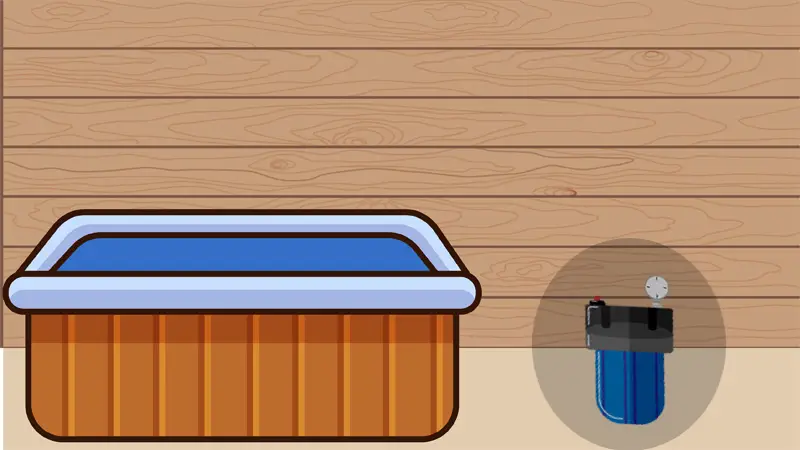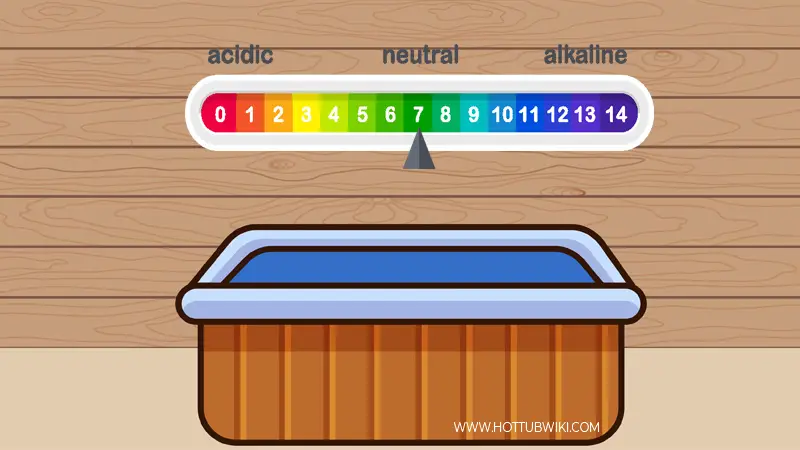As a hot tub owner, you must have heard several tales about salt water hot tubs and the many benefits the users enjoy. Maybe you want to enjoy these benefits and luxury too but you aren’t sure how to go about it or maybe you don’t even know what a salt water hot tub is, to begin with.
Not to worry, this post will introduce you to and explain all you need to know about salt water hot tubs as well as how to convert your hot tub to one. So let’s get on with it. First, let’s check out what we mean by salt water hot tubs.
What Is a Salt Water Hot Tub?
A salt water hot tub uses salt for cleaning the water instead of sanitizers like bromine. But it’s more than that. With a salt water hot tub, salt is not just poured directly into the water. There is a salt dispenser known as the salt cell chlorinator located in or around the hot tub.
The salt cell chlorinator generates its chlorine from the salt cells. The chlorine that is generated is now added to the water in the hot tub at specific intervals and regular quantities.
When we say salt, we don’t mean your table salt. While that will work, it will take forever to be dissolved. Salt water hot tubs use a special salt called hot tub salt.
How Much Does It Cost to Convert a Hot Tub to Saltwater?
It will cost you anywhere between $300-500 to convert your chlorine (or bromine) hot tub to saltwater. The chlorinator costs about 400 dollars, plus the salt costs about $30.
If you hire someone to do it, it will cost even more. That’s why we have prepared this guide to show you how to do it yourself. In the long run, it will cost you less to maintain the saltwater hot tub than a chlorine hot tub.
Can Any Hot Tub Use Salt Water?
The first thing to do before going ahead with this is to check if your hot tub can be converted to a salt water hot tub. Not all hot tubs can do this which can be a bit of a bummer especially if yours can’t.
Consult your hot tub manufacturer or have a professional hot tub installer help you out with this. If you have confirmed the hot tub can be converted to a salt water hot tub, then you are ready to go.
Benefits of Salt Water Hot Tub
A salt water hot tub has a host of benefits.
Cheaper
For starters, it is a cheaper option.
With regular hot tubs, you will always need to spend cash on sanitizers and chemicals which for the record can be a bit much. But with salt water hot tubs, you just need to spend cash on cheaper salt.
Odorless Hot Tub
When you add chlorine to your hot tub water, it produces chloramines. The process produces a lot of toxic smells in the air.
You wouldn’t even be able to stay near freshly chlorinated hot tub water. This is not the case with salt water hot tubs. There is usually no odor or toxic smell in the air since salt is used.
Eco-friendliness
Salt water hot tubs are also eco-friendly since no toxic waste or odor is spewed into the atmosphere.
Maintenance-free
Salt water hot tubs are maintenance-free. You usually don’t need to worry about adding sanitizers and chemicals to the water. The chlorinator does that for you. So you can spend less time worrying about sanitizer levels and more time enjoying the hot tub.
A little heads up though. Though the need for maintenance is reduced, you will still need to occasionally shock the spa. Many people wouldn’t tell you this.
Soft Water
The water in a saltwater hot tub is softer than that in a regular hot tub. This is because salt is a natural remedy to reduce the hardness of water and since that’s what you indirectly put in the hot tub, it’s only expected to have softer water in the tub and this enhances your hot tub experience.
Bye to Chloramines
Saltwater hot tubs control the effect of chloramines in the water. Saltwater hot tubs add little chlorine to the water and at regular intervals, the effects of chloramines in the water are drastically reduced.
This means you don’t have to worry about burning sensations in your eyes, lungs, or nostrils anymore.
Stable Water Chemistry
The water chemistry in a salt water hot tub is also balanced. Since the chlorinator only adds chlorine when needed, you don’t have to spend so much time testing and retesting the water to be sure the chemistry is balanced.
Downsides Of A Salt Water Hot Tub
Saltwater hot tubs come with some downsides, here they are:
- Expense – Saltwater hot tubs cost less to maintain, but if the saltwater generator stops working, then you need to buy a new one. And, they cost a lot. You will have to spend about $400 to replace a chlorine generator.
- You Still Have To Shock – Salt water hot tubs don’t need as much maintenance as chlorine hot tubs do. But, you still have to check the water chemistry and shock the hot tub occasionally. A non-chlorine shock will be always necessary.
- They Are Not Corrosion Free – A lot of people believe that saltwater hot tubs are corrosion-free, that’s false. Saltwater can still corrode the hot tub, especially the hot tub heater.
How to Convert to a Salt Water Hot Tub?
Let’s see how you can convert your normal hot tub to a salt water hot tub.
1. Choose a Chlorinator (Or Bromine Generator)
Two types of chlorinators can be used with a salt water hot tub. You can use a drop-in chlorinator or an in-line chlorinator. The drop-in chlorinator is a top choice for many hot tub users because it is very easy to install.
The drop-in chlorinator can be dropped right into the water. The in-line chlorinator on the other hand has a more complex setup. The in-line chlorinator needs to be installed with the plumbing lines of the hot tub. This way, it becomes part of the hot tub’s circulation.
This is usually a task for an experienced plumber which is why it’s not a top choice for many hot tub owners. If you have selected your chlorinator, you can go ahead with the task. But you will need a few tools.
- A drop-in salt water chlorinator
- Garden hose and hose filter
- Hot tub line flush
- Hot tub cleaner
- Soft sponge
- Salt and chlorine test strips
- Hot tub salt
- Chlorinator manual
2. Drain, Clean & Re-fill the Hot Tub
Locate the drain valve at the base of your hot tub. You need to remove it or turn it to allow the water from the hot tub to escape. You might also need a screwdriver or a wrench if you have an old model drain valve.
After draining the hot tub, you should clean it. Use rubbing alcohol or bleach to clean the hot tub shell and hot tub filters. You should also clean the hot tub plumbing.
After you clean and rinse the hot tub, it’s time to fill it. Ensure to use a hose filter while filling the hot tub with water. The hose filter will limit the contaminants that get into the hot tub water.
3. Test the Water For Salinity
After refilling the hot tub, test the water in the tub for salinity. Even fresh water has some salt in it, you need to know the right amount of salt so you don’t add too much.
You can use salt testing strips for this. The chlorinator will increase the salinity of the water between 2000ppm to 3000ppm. So, the salinity of the water before installing the chlorinator should be way below this.
You should also test the water chemistry. You can use regular test stips. Test the alkalinity, acidity, and iron levels in the water. If the levels are off, you should adjust them.
You can use a pH increaser and a pH decreaser to adjust the water acidity and alkalinity. For the iron level in the water, you can use a metal remover if the iron levels are high.
The correct levels for a hot tub are:
- Ph balance: 7.2 to 7.8
- Alkalinity: 80ppm to 120ppm (parts per million)
- Chlorine: 1ppm to 3ppm
- Bromine: 3ppm to 5ppm
- Water hardness: 80ppm to 200ppm.
So, adjust as needed.
4. Install the Chlorinator Panel
Just like your hot tub, the chlorinator also has a control panel. The panel should be installed away from the water. You can install it on the wall with your GFCI breaker or a post. You can use electrical tape to secure the chlorinator.
While installing the control panel, ensure the plug can reach the GFCI breaker and the chlorinator can reach the water. Also, keep the control panel in line of sight so you can monitor it even when you are in the hot tub. Do not plug in the cords just yet.
Related Read: Salt Water vs Chlorine Hot Tubs?
5. Attach All the Cables and Put the Chlorinator in the Hot Tub
As indicated by the chlorinator’s manual, attach all the cables correctly into their outlets. You should also add the required amount of hot tub salt to the chlorinator’s system.
When you have done that, put the chlorinator inside the hot tub water. Remember that this is a drop,-in chlorinator so it can stay in the water. For an in-line chlorinator, it can’t stay in the water.
6. Plug the Cord
Plug the cord of the chlorinator into an outlet. Ensure it is properly plugged in and the outlet is strong enough to generate power to the chlorinator without blowing up. Also, ensure no wires are laying around so you don’t trip or step on them.
Related Read: How To Lower Salt Level in a Hot Tub?
7. Test the Chlorinator
Start the chlorinator and give it a go. Check the control panel for indication if the chlorinator is working fine. If the control panel indicates it is working well, leave it for a while then retest the water.
Using your test strips, test the water in the hot tub for chlorine levels. The test result should show that you have a higher chlorine level in the hot tub than when you just refilled the water. If this is the case, that means you have successfully installed the chlorinator.
If the chlorine levels are low, let the chlorinator work for a while again and retest the water. If the chlorine levels remain unchanged after a few hours, it means you didn’t install the chlorinator properly or there isn’t enough hot tub salt.
So, turn off the hot tub and check the salt level and all the connections again. Then let the chlorinator work for a few hours and have the water retested. If the chlorine levels remain unchanged, it means the chlorinator is faulty. Put a call through to your local hot tub dealer to help you out.
Now you know how to install a drop-in chlorinator in your hot tub.
Related Read: 8 Most Common Questions About Salt Water Hot Tubs
[su_youtube url=”https://www.youtube.com/watch?v=q8KRKGZrMfE”]
Enjoy The Salt Hot Tub
Overall, a salt water hot tub is amazing. It gives your hot tub experience a whole new meaning. Sure it has its many benefits, but it also requires a good deal of maintenance and cleaning.
But with the right cleaning routine and regular check-up, you are sure to enjoy the new modification to your hot tub. So, give it a go and see what you find out. Have a nice day.


